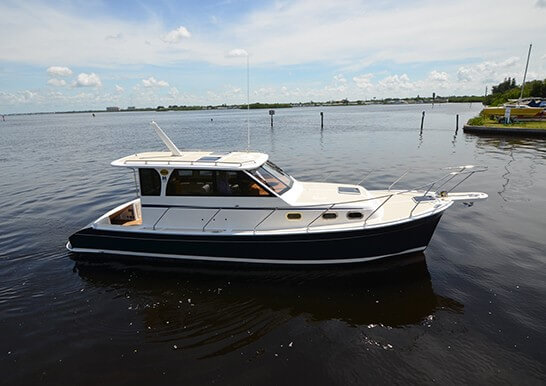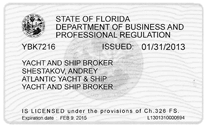Marlow-Mainship 34 Yacht Review
Posted 2016/06/30 at 1:46 in Yacht Reviews

The Marlow Mainship 34 has set a different pace from the normal qualities present in many boats. Most boats have a one drive-train configuration and use two sets of speeds: high and low. The Marlow 34 however isn’t restrained to just these options and may be ordered with a single engine, or a twin-engine propulsion package.
Performance
A sea trial was done under mild weather conditions on Tampa Bay with the most noticeable trait being her tracking nature. She easily maintained course for a number of minutes without guidance from the driver. She is very sharp and handled the broad turns quite well for a twin engine boat. Bow rise was above five degrees and the high helm seats gave us clear sightlines forward when we came out of the hole. The boat maneuvered the dock quite easily even without a bow thruster. Hopefully the owners of the single-engine version, which have been said to be very economical, will add the bow thruster to their boats.
Construction
The 34 was built using modern procedures and materials. The totality of the hull is cored with Nida Core which is a very tough and stretchy sheet sandwich material made from interstitial layers of attached honeycomb-like octagons connected in the middle of two non-woven polyester scrims. The Nida Core is held firmly, through a vinylester-resin-infusion method, between the inner and outer layers of the hull which is made from fiberglass and a complete glass. Structural foam-filled stringer grid is used to make the hull strong and stiff from inside.
The Chief of Marlow Mainship, David Marlow, used screw holes to design the hull-to-deck joint in a kind of shoebox-like joint, to stop water from entering the hull. The two outward turning flanges; one coming from the deck and the second from the hull, are juxtaposed and glued shut with 3M5200, which is a permanent, semi flexible agent. To further prevent water outward, mechanical fasteners, rub rail and bang strips were used in the seal. The propellers are protected by running Kevlar and carbon fiber along the keel, base of the stem and in the strut keel. The engineering skills used on board are the best, for instance, a fuel tank was placed at the longitudinal center of gravity to prevent trim issues that could be caused by fuel burn. There is also a light but solid aeronautical-style longitudinal framing system which has many beefy ring frames.
Accommodation
She has a very simple layout. Below the decks, is an island berth forward which has two cedar lined hanging lockers; at the far back, a galley and head with a shower stall is located to port, and a U-shaped dinette to starboard. At the topside, there are swivelling helm seats forward; and backward are the reversible lounge seats and tables. The cockpit houses enormous folding cleats. The decks are coated with SeaDek which is a closed-cell copolymer product which is non-absorbent and looks like teak decking.
LOA: 39’8″
BEAM: 12’4″
DRAFT: 2’8″
DISPL.: 15,000 lb.
FUEL: 280 gal.
WATER: 105 gal.
TEST POWER: 2/260-hp Yammar 6by3-260
TRANSMISSION: ZF 63A; 2.52:1
PROPELLERS: 22X18 4-BLADE BRONZE
| RPM | KNOTS | GPH | RANGE | DBA |
|---|---|---|---|---|
| 600 | 4.3 | .8 | 1355 | 67 |
| 1000 | 5.6 | 1.2 | 1176 | 71 |
| 1500 | 7.2 | 1.6 | 1134 | 74 |
| 2000 | 8.2 | 4.8 | 431 | 77 |
| 2500 | 10.6 | 9.2 | 290 | 80 |
| 3000 | 14.7 | 12.4 | 299 | 82 |
| 3500 | 17.4 | 16.4 | 267 | 85 |
| 4100 | 23.9 | 25 | 241 | 90 |














